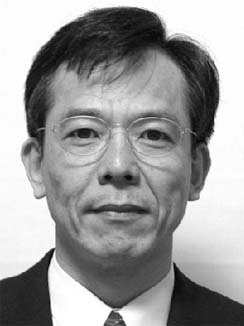


 تاريخ الرياضيات
تاريخ الرياضيات
 الرياضيات في الحضارات المختلفة
الرياضيات في الحضارات المختلفة 
 الرياضيات المتقطعة
الرياضيات المتقطعة
 الجبر
الجبر
 الهندسة
الهندسة 
 المعادلات التفاضلية و التكاملية
المعادلات التفاضلية و التكاملية 
 التحليل
التحليل
 علماء الرياضيات
علماء الرياضيات |
Read More
Date: 24-3-2018
Date: 24-3-2018
Date: 21-3-2018
|
Born: 23 February 1951 in Nagoya, Japan

Shigefumi Mori attended Kyoto University and he received his B.A. from there in 1973 and his M.A. in 1975. In that year he was appointed as an assistant at Kyoto and studied there for his doctorate under Masayoshi Nagata's supervision. He was awarded his doctorate in 1978 for a thesis The endomorphism rings of some abelian varieties.
After the award of his Ph.D., Mori remained as an assistant at Kyoto until 1980 when he was appointed as a lecturer in mathematics at the University of Nagoya. He was promoted to assistant professor in 1982 and, in 1988, to full professor. In 1990 Mori returned to a chair at Kyoto University.
During the years from 1977 to 1988 he spent much time in the United States despite the positions he held in Japan. He was visiting professor at Harvard during 1977-1980, the Institute for Advanced Study in 1981-82, Columbia University 1985-87 and the University of Utah for periods during 1987-89 and again during 1991-92.
Mori works on algebraic geometry. To put his work in perspective we should note that, as in many areas of mathematics, classification is the ultimate aim. As Hironaka writes in [4]:-
... to classify algebraic varieties has always been a fundamental problem of algebraic geometry and even an ultimate dream of algebraic geometers.
Major progress was made on classifying algebraic surfaces during the first part of the 20th century by the great Italian algebraic geometers led by Castelnuovo, Enriques and Severi. Progress in this line continued with Zariski's contribution during the 1950s, followed by Kodaira's work in the following decade. Mori's work achieved a remarkable continuation of classification efforts in algebraic geometry and in many ways provides a fitting chapter in the progress of algebraic geometry through the 20th century.
Mori was awarded a Fields Medal at the 1990 International Congress which was held in the city in which he had studied as a student, namely Kyoto in Japan. He received this Medal for some remarkable work over a 12 year period. He worked on algebraic manifolds with ample tangent bundles and was the first to prove the Hartshorne conjecture in 1978. This conjecture, posed in 1970, claimed that projective spaces are the only smooth complete algebraic varieties with ample tangent bundles.
In 1981 Mori completed the classification of Fano 3-folds and worked on the minimal model programme.
Hironaka, speaking of Mori's work which led to the award of the Fields Medal said [4]:-
The most profound and exciting development in algebraic geometry during the last decade or so was the Minimal Model Program or Mori's Program in connection with th classification problems of algebraic varieties of dimension three. Shigefumi Mori initiated the program with a decisively new and powerful technique, guided the general research direction with some good collaborators along the way, and finally finished up the program by himself overcoming the last difficulty.
Mori has received many other awards for his outstanding work. Before receiving the Fields Medal in 1990 he had already been awarded the Japan Mathematical Society's Yanaga Prize in 1983, the Chunichi Culture Prize in 1984. In 1988, jointly with Y Kawamata, he received a Prize from the Japan Mathematical Society for:-
...outstanding work in the minimal model theory for algebraic varieties.
In 1989 he received the Inoue Prize for:-
...outstanding work in the theory of higher dimensional algebraic varieties and in particular for the proof of existence of minimal models for 3-dimensional algebraic varieties.
The same year as he was awarded the Fields Medal, in 1990, Mori was awarded the Cole Prize in Algebra from the American Mathematical Society. The citation for the award states [8]:-
The committee unanimously recommends that the 1990 Cole Prize in Algebra be awarded to Shigefumi Mori for his outstanding work on the classification of algebraic varieties. Mori took the decisive steps over a ten-year period in extending the classical theory of algebraic surfaces to dimension three: prior to Mori's breakthroughs this problem seemed out of reach. Mori's beautiful work also makes major inroads into the problem in higher dimensions.
In 1998 Mori published the monograph Birational geometry of algebraic varieties which he coauthored with János Kollár. Mark Gross writes in a review:-
The minimal model program, or Mori's program, was one of the great successes of algebraic geometry in the 1980s. The basic goal was to understand the birational geometry of threefolds in a way analogous to the birational theory of surfaces. This approach got its start with work of Mori ... The book under review, written by two of the leaders in the field, is a comprehensive treatment of the minimal model program. ...
Mori continues to publish important papers such as: Rational curves on algebraic varieties (2000), (with O Fujino) A canonical bundle formula (2000), Semistable extremal neighborhoods (2002), (with V Alexeev) Bounding singular surfaces of general type (2003), and (with Y Prokhorov) Q-conic bundles (2008).
Articles:



|
|
|
|
علامات بسيطة في جسدك قد تنذر بمرض "قاتل"
|
|
|
|
|
|
|
أول صور ثلاثية الأبعاد للغدة الزعترية البشرية
|
|
|
|
|
|
|
مكتبة أمّ البنين النسويّة تصدر العدد 212 من مجلّة رياض الزهراء (عليها السلام)
|
|
|